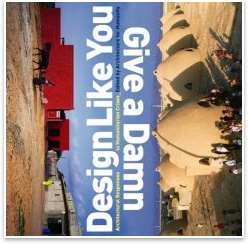
Humanitarian Architect Believes Sustainability a Necessity
Summary: Cameron Sinclair, cofounder and executive director of California-based Architecture for Humanity and author of Design Like You Give a Damn: Architectural Responses to Humanitarian Crises, addressed a gathering of approximately 40 architects and students September 25 at Ashoka Headquarters in Arlington, Va. Sinclair shared his recent humanitarian design experiences working on sustainable renewal projects in the Mississippi Gulf Coast, post-tsunami India and Sri Lanka, war-torn and earthquake-impacted countries, and poverty-stricken worldwide villages.
“These are groups that can benefit from sustainability,” Sinclair urged the attendees. “The push for oil will not be high on the agenda; it will be for water and housing.” Sinclair detailed his sustainable building projects in the Gulf Coast, including the Biloxi Model Home Program to help families repair and rebuild homes. He also described his projects in areas of the world suffering from poverty, earthquakes, and war. These included: mobile HIV/AIDS clinics in Africa; shelters for people affected by the Asian tsunami in India and Sri Lanka; bridges in China; refugee camps in Iran; temporary housing in Chile; earthquake-resistant housing and refugee camps in Afghanistan and Pakistan; schools in India; and community centers in Senegal, India, and Brazil.
What to do?
Sinclair stressed that architects must “design with pride, not pity.” His wish is to improve the living standards of five million people: “We have two options—architecture or revolution. The difference is revolution can be avoided.” Design Like You Give a Damn: Architectural
Responses to Humanitarian Crises, honors the achievements of humanitarian architects and designers
who, as Sinclair says, “do not get the media coverage.” He
noted that book proceeds support projects to assist local communities
worldwide. The book details more than 80 worldwide projects that
address urgent needs, such as basic shelter and access to clean water,
energy, and sanitation. |
||
Copyright 2006 The American Institute of Architects. All rights reserved. Home Page |
||
news headlines
practice
business
design
recent related
› Architecture for Humanity—The Beginning
› FEMA Adopts Key AIA Recommendations on Katrina Housing
› Architects Get Involved in AIA’s Disaster Assistance Program
Visit
the Architecture for Humanity Web site. ![]()
The AIA Bookstore carries Design Like You Give a Damn, edited by Architecture for Humanity ($31.50 AIA members/$35 retail). Proceeds from the sale of this book will support the work of Architecture for Humanity.

 A self-described “black sheep” in the field of architecture,
Sinclair emphasized the opportunity for sustainability practices
in reconstruction projects for displaced populations affected by
natural disaster, poverty, and refugee flight, stressing that sustainability
is not a luxury but a worldwide necessity. He supported that argument
by pointing out:
A self-described “black sheep” in the field of architecture,
Sinclair emphasized the opportunity for sustainability practices
in reconstruction projects for displaced populations affected by
natural disaster, poverty, and refugee flight, stressing that sustainability
is not a luxury but a worldwide necessity. He supported that argument
by pointing out: “Designers are not recovery experts,” he acknowledged,
stressing that it is more important for architects to take a community-involvement
approach to reconstruction by learning as much as they can about
the local culture, especially in a foreign land. His presentation
underscored that “architects should design with the community
and not for it,” adding that involving an entire foreign village
in the design and building process is paramount to community ownership
and the local economy. “We must help arm communities with expertise,
technology, and social capital,” Sinclair encouraged the attendees.
“Designers are not recovery experts,” he acknowledged,
stressing that it is more important for architects to take a community-involvement
approach to reconstruction by learning as much as they can about
the local culture, especially in a foreign land. His presentation
underscored that “architects should design with the community
and not for it,” adding that involving an entire foreign village
in the design and building process is paramount to community ownership
and the local economy. “We must help arm communities with expertise,
technology, and social capital,” Sinclair encouraged the attendees.